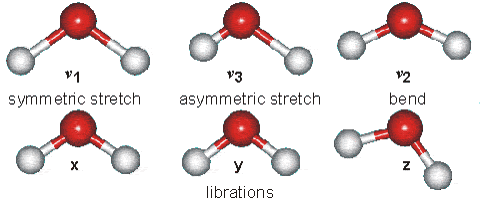















The water molecule may vibrate in a number of ways. In the gas state, the vibrations involve combinations of symmetric stretch (v1), asymmetric stretch (v3) and bending (v2) of the covalent bonds.
|
Gas |
v1,
cm-1 |
v2,
cm-1 |
v3,
cm-1 |
|---|---|---|---|
|
H216O |
3657.05 |
1594.75 |
3755.93 |
|
H217O |
3653.15 |
1591.32 |
3748.32 |
|
H218O |
3649.69 |
1588.26 |
3741.57 |
|
HD16O |
2723.68 |
1403.48 |
3707.47 |
|
D216O |
2669.40 |
1178.38 |
2787.92 |
|
T216O |
2233.9 |
995.37 |
2366.61 |
|
Vibration
|
liquid H2O (25°C) |
liquid D2O (25°C)
| ||
|---|---|---|---|---|
|
v, cm-1 |
E0,
M-1 cm-1 |
v, cm-1 |
E0,
M-1 cm-1 | |
| v2 |
1643.5 |
21.8 |
1209.4 |
17.4 |
| v2+ libration |
2127.5 |
3.50 |
1555.0 |
1.91 |
| v1+v3+v2 (overtone) |
3404.0 |
99.9 |
2504.0 |
71.5 |

Next Chapter:
KEELY'S THEORIES
Contact:
Hans von Lieven, copyright 2007